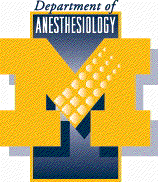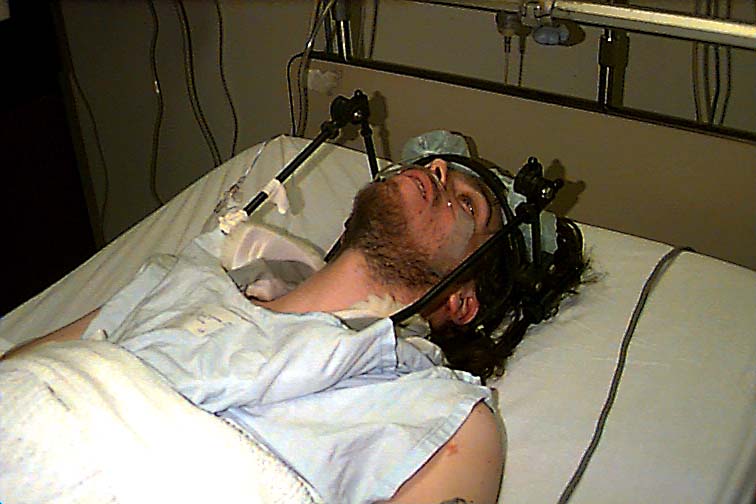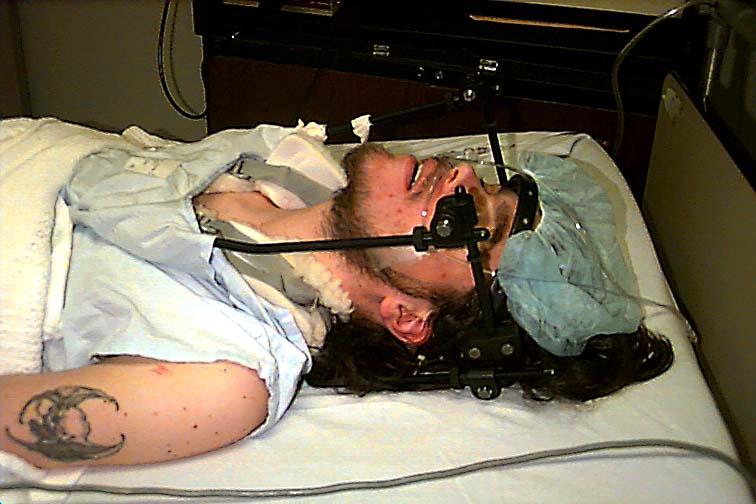 Go to Front Page
Go to Front Page
 Go to Scenarios
Go to Scenarios
 Go
to Techniques
Go
to Techniques
Apparent Difficult Airway - Anatomy,
Injury, Physical/Mechanical Problems

The difficult airway may be due to anatomic reasons: large tongue, short
neck, limited extension, etc. Facial or neck trauma may distort the airway
and blood may make visualization difficult though this may not be apparent
from the external appearance of the patient. There may also be upper airway
injury or physical/mechanical hindrance, i.e. a halo or jaws wired shut.
Techniques:
Awake direct laryngoscopy
Awake fiberoptic
Surgical airway
If there appears to be any reason to think that controlling the airway will
be difficult it is imperative to not take away the patient's ability to
spontaneously ventilate [reference8].
If a patient's ability to spontaneously ventilate is removed and if the
clinician cannot intubate there may also be difficulty ventilating, this
is an acute emergency. A patient that can no longer oxygenate or ventilate
and some other form of airway
must be rapidly obtained.
If an awake techniques is used, the patient will require some form of topical
anesthetia. The patient may require minimal sedation,
especially if uncooperative, remembering that with sedation there may be
respiratory depression, circulatory depression and disinhibition.
It may be prudent to immediately go to a surgical
airway under local. This allows the patient to continue to maintain
their own airway and the clinician to gain control of the airway. This may
be the only option if other methods have been exhausted.
The apparent difficult airway is frustrating in that it turns a potentially
easy airway into a potentially difficult one. It is mportant to remember
that problems with airway management may often occur and that the proper
personnel and equipment should be available, in the event a surgical airway
is needed [reference 9]. A surgeon
can be used to apply cricoid pressure
[reference 11].
Known Difficult Airway
In this situation, the difficult airway is known and that it limits options.
Techniques:
Awake direct laryngoscopy
Awake fiberoptic
Surgical airway
Spontaneous respiration should be maintained [reference
8] in the event the airway cannot be quickly secured. Adequate topicalization
is essential along with minimal sedation.
In the difficult airway, the airway can easily be lost, therefore the necessary
equipment/personnel need to be available in the event a surgical airway
is needed.
The difficult airway that needs to be emergently intubated is a very tenuous
situation. It is helpful to have experienced hands available for assistance
in the event they are needed [reference
9].
Unstable Cervical Spine
 Halo fixation
Halo fixation
Cervical spine (C-spine) injuries occur in 1.5%-3.0% of all major trauma
cases [reference 10].When a patient
with an unstable C-spine needs to be intubated, either emergently or prior
to an operation, it is important to protect the C-spine. Care must be taken
not to cause any excessive movement of the neck which might cause neurologic
deficit. Patients who already have a deficit, eg are quadriplegic on admission,
should be treated in the same manner as woresening of the injry may occur.
Neurologic deficit may be secondary to edema and may improve with time.
No single technique has proved to be better and that it has been suggested
that any technique that the clinician is skilled at can be used successfully.
However, it has been shown that the basic airway maneuvers of the chin lift
and jaw thrust have been shown to cause problems secondary to movement and
should be avoided.
Techniques:
Awake fiberoptic
Blind nasal
Rapid Sequence Intubation with
in-line stabilization
Awake fiberoptic is good choice as long as neck motion can be kept to a
minimum. However the airway can be full of secretions or blood and the patient
may not be cooperative, which can make this technique impossible.
Blind nasal intubation can be used. Minimal neck movement maintenance of
spontaneous ventilation are benefits of this choice. Blind nasal intubation
can be performed in a patient who is not cooperative. It is contraindicated
if there is basal skull fracture or if there is a fear of disruption of
the ethmoid plate; case reports have described the ETT entering the brain
substance. The major risks of the blind nasal are epistaxis, vomiting and
regurgitation. If any of these do occur they may make awake fiberoptic intubation
difficult.
Rapid Sequence Intubation (RSI) can be accomplished with the aid of manual
in-line stabilization of the head and neck. In-line stabilization is performed
by having the patient lie supine with the head in the neutral position;
an assistant grasps the mastoid processes, the front of the semi-rigid collar
is removed; the collar can impede mouth opening, does not contribute significantly
to neck stabilization during laryngoscopy, and will be an obstruction if
a surgical airway is required. Manual in-line stabilization reduces neck
movement during intubation, but care is taken to avoid excessive axial traction
which may cause distraction and subluxation. This technique requires a minimum
of three, but ideally four, individuals: the first to pre-oxygenate and
intubate: the second to apply cricoid pressure; the third to maintain manual
in-line stabilization of the head and neck; and the fourth to give intravenous
drugs and assist. A gum elastic bougie should be kept at hand and is used
immediately if the view is obscured and/or intubation proves difficult.
The posterior portion of the semi-rigid collar, which is left in place during
the entire maneuver, helps to prevent flexion of the cervical spine during
the application of firm cricoid pressure [reference
11].
The best technique to intubate a patient with an unstable C-spine has not
been decided . The procedure chosen should be the one that the practionar
is most familiar. It has been suggested that in the hands of an experience
practioner, the procedure of tracheal intubation in a patient with a C-spine
injury is a "low-risk intervention."
Combative Patient
Techniques:
Rapid sequence induction
Awake techniques
The combative patient may be extremely difficult to intubate awake. The
patient who is combative and seriously injured can be paralyzed and intubated
to facilitate physical examination of the patient. Care should be taken
to stabilize the neck if cervical injury is
a possibility. Consideration should be given to the patient's overall condition
and any contraindications to paralysis should be sought, eg potential difficult
airway. The patient will not cooperate with any awake techniques, therefore,
the option is rapid sequence intubation.
Emergency paralysis with intubation can be an effective method of restraint
for the uncooperative, combative, serioulsy injured patient. However, given
the risks of paralysis and intubation, this should be avoided unless absolutely
required.
 Go to Front Page
Go to Front Page  Go to Scenarios
Go to Scenarios  Go
to Techniques
Go
to Techniques